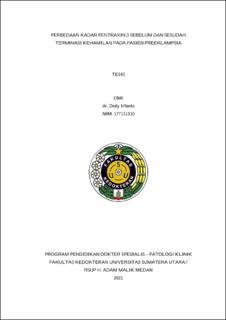Perbedaan Kadar Pentraxin 3 Sebelum dan Sesudah Terminasi Kehamilan pada Pasien Preeklampsia

Date
2021Author
Irfanto, Dedy
Advisor(s)
Lubis, Zulfikar
Siregar, Muhammad Fidel Ganis
Metadata
Show full item recordAbstract
Background : Preeclampsia is a disorder during pregnancy characterized by hypertension, proteinuria, and edema that occurs after 20 weeks of gestation. The inflammatory response contributes significantly to the pathology of preeclampsia, including endothelial dysfunction and placental dysfunction. Pentraxin 3 (PTX3) is one of the inflammatory mediators produced by endothelial cells, monocytes, macrophages,and fibroblast. The exaggerated inflammatory response in preeclampsia increases PTX3 levels in the maternal circulation.
Objective : Determine the difference in PTX3 levels before and after termination in preeclampsia patients.
Methods: This research is an observational study with a prospective cohort data collection method.This study took blood samples from preeclampsia patients before and after termination of pregnancy who were treated at RSUP H Adam Malik as many as 30 patients who had met the inclusion criteria. Bivariate analysis using paired T-test and p value < 0.05 was considered significant.
Research Results: The mean pentraxin 3 level before termination was 12.65 ng/mL with lowest level 10.1 ng/mL and highest level 18.24 ng/mL. Meanwhile after termination, pentraxin 3 decreased about 7.33 ng/mL with lowest level 5.34 ng/mL and highest level 9.12 ng/mL. Wilcoxon test shown that there was a difference pentraxin 3 levels before and after pregnancy termination (p<0.001).
Conclusions and recommendations: PTX3 in PE patients before termination tends to be higher and PTX3 examination is recommended for pregnant women with suspicion of preeclampsia.
Collections
- Master Theses [162]
